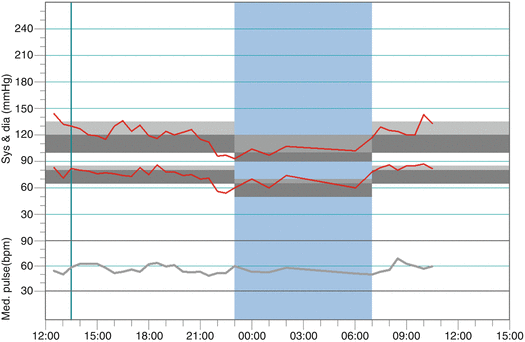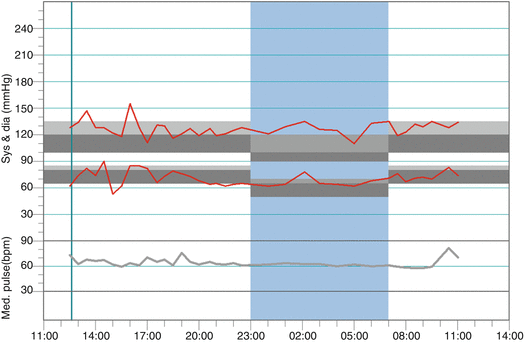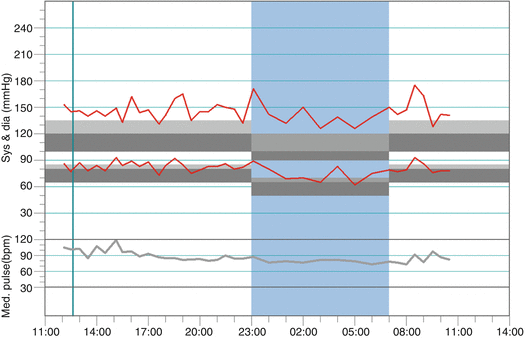, Mark Thomas1 and David Milford2
(1)
Department of Renal Medicine, Birmingham Heartlands Hospital, Birmingham, UK
(2)
Birmingham Children’s Hospital, Birmingham, UK
Abstract
In this chapter we explain:
The benefits of patients managing their own blood pressure
Diurnal rhythm in blood pressure
The importance of night-time blood pressure
The role of blood pressure in progressive kidney disease
Blood pressure is a simple and informative physiological measurement. Inexpensive and accurate automated arm cuff meters are available in chemist shops. Wrist meters are not recommended; they can give inaccurate readings.
Blood pressure measured in the surgery or clinic may be affected by the ‘white coat’ effect . This can increase the systolic blood pressure by 30 mmHg or more, even in patients who are not overtly anxious. The size of the effect increases with the underlying blood pressure, making clinic readings of limited value for monitoring blood pressure control. Home blood pressure readings are much more useful.
Patients should be instructed in how to adjust their blood pressure treatment in response to their home readings. In a randomised trial comparing self-monitoring and self-titration of antihypertensive medication versus usual primary care, systolic blood pressure was on average 9 mmHg lower in the self-managing group after 12 months, without any increase in side effects. This big difference would probably lead to a significant improvement in longer-term outcomes [1].
There is often a difference in blood pressure between the two arms [2]. This is more common in people with hypertension, diabetes and chronic kidney disease and is associated with an increased risk of cardiovascular and all-cause mortality. It is recommended to use the higher reading to guide treatment decisions.
Patients with a difference in blood pressure between the two arms of more than 35 mmHg may have an atherosclerotic stenosis of one subclavian artery. Smaller inequalities are more likely to be due to differences in the stiffness of the arteries in the arm than to localised stenotic lesions.
Diurnal Variation in Blood Pressure
Blood pressure normally follows a pattern across the 24 h cycle – the diurnal rhythm . It dips before sleep then rises before wakening (Fig. 10.1).


Fig. 10.1
A normal 24 h blood pressure recording showing the diurnal rhythm
In people with chronic kidney disease, this nocturnal dipping pattern is often lost; a non-dipping pattern being increasingly common as GFR decreases (Fig. 10.2).


Fig. 10.2
24 h blood pressure recording in someone with chronic kidney disease. Daytime readings are normal but there is no dip during the night
In patients with hypertension, the nocturnal dip may be lost so that the relative elevation in pressure is greater during the night than the day (Fig. 10.3).


Fig. 10.3




24 h blood pressure recording in someone with hypertension. Most daytime readings are elevated and there is only a small dip during the night. The hypertension is effectively worse during the night
Stay updated, free articles. Join our Telegram channel

Full access? Get Clinical Tree








